Novi Sad attracts the visitors with its neatness, safe embeddedness beneath the Petrovaradin Fortress – the “Gibraltar on the Danube”, different languages spoken by its inhabitants, festivals, fairs, and rhythm so untypical for hasty and chaotic pace of an urban community. Even the clock at the Fortress shows hours with its big hand and warns to the fact that minutes can sometimes wait for a moment of beauty to be absorbed, or for a friendly chat, strolling along the Danube sand, joy of walking after a spring rain, or Sunday lunch to be brought to an end. Novi Sad rhythm of authentic relaxed and “easy going” atmosphere vibrates beyond the city borders as well – at “salaš” farmsteads, the Danube “čardas” (famous fish restaurants), beaches or above the Fruška Gora vastness.
The life that is being deeply inhaled here, is carried later on as the taste of warm poppy “Strudel”, and “Schneenockerl”, those that are suddenly left behind a family lunch at a “salaš” farmstead, as a reminder of the warmth of a simple stove around which the young and the old gather during the winter. Novi Sad to go is the feeling of warmth of a spring day on the Danube or snowy whiteness traversed by horses harnessed in sleighs with chiming bells, filled with singing voices of “salaš” farmstead guests warmed up with “rakija” and wine. This is also the memory of the cosiness of conversation, or tastes and scents of the dining table filled with most diverse goodies of Vojvodina cuisine and Fruška Gora wines: Riesling, Neoplanta, Semillon, Sirmium, Slankamenka, Bermet, etc.
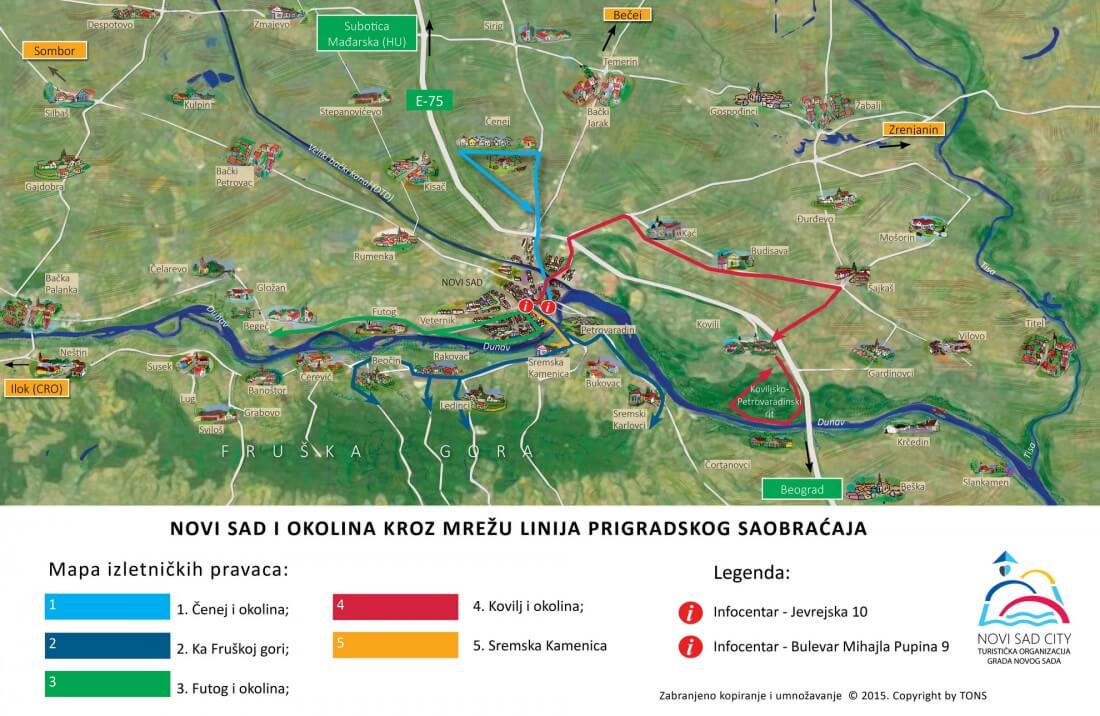
If you set off along the old Subotica road to which you are taken by Sentandrejski road, and drive for some ten kilometres through a pleasant countryside, you will come to Čenej, an old Bačka village, currently known as the settlement of “salaš” farmsteads. This is where you can slow down the time at least for a moment and enjoy in the ambience typical for rural households in Vojvodina, in the shade of an orchard, with traditional food and good wines. “Salaš” farmsteads are houses with economic structures scattered in the sea of Vojvodina land. Today, they are the keepers of the spirit of the past times, slow-paced way of life, homemade food, wine, and horses running across the flatland.
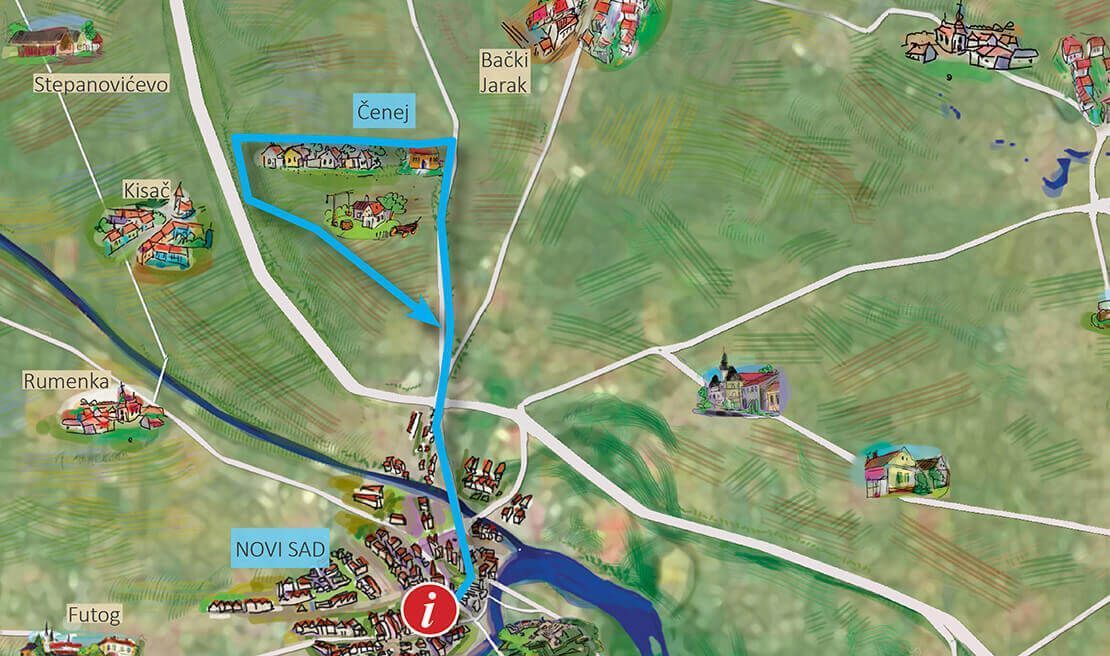
Salaš 137, Međunarodni put 137;
Closed on Mondays.
Advance booking recommended.
www.salas137.rs
Here, in the kingdom of silence, cosy and relaxed atmosphere, you will enjoy in horse riding and fiacre ride, rich offer of Vojvodina specialities and relax after that in one of authentic rooms in the “Alt Deutsch” style.
Pajin salaš, Međunarodni put 325;
www.pajinsalas-restorannovisad.com
Pajin salaš is the oasis of peace, and an excellent choice for organising of family and business lunches, family and business celebrations. It is known after good food (Mangulitsa ham hock, chicken pillows, etc.). Booking recommended.
Equestrian Centre for Rehabilitation, Recreation, Relaxation and Education “U sedlu” Salaš 341,
The Equestrian Centre “U sedlu” is a unique concept that includes the activities and therapies for children and adults with special needs with the assistance of horses, as well as team building and leadership programmes with the assistance of horses (certified EAHAE member). It is possible to rent the entire estate with full service and organisation of events, or opt for a tailor made concept without any intrusion. Therapies are booked according to a certain procedure and the estate itself is of a closed type so that arrangements in advance are mandatory.
Kamp “Farma 47” Camp, Međunarodni put bb,
Farma 47, a camp, overnight lodging and “salaš” farmstead is located at about ten kilometres from the centre of Novi Sad, within Čenej district. Farma 47 Auto Camp disposes with 20 auto-homes, electricity and water connections and possibility of waste water discharge. There are also 4 comfortable rooms and one suite. All that is settled within an excepted “salaš” farmstead landscape with domestic animals, orchard with 1,300 quince trees, relaxed time without any rush, noise and garnish that includes (as desired) eggs of domestic grown chicken, ham, bacon, compote, jam and homemade fruit brandy.
Brkin salaš, Međunarodni put 312
Make sure to book in advance
www.brkinsalas.rs
Brkin salaš is a household of the family Matić where you can feel the charms of salaš way of life, in a peaceful atmosphere, with no hurry; here you can also organise the celebrations of important events events with traditional Vojvodina cuisine and music of tamburica players.
Mitin salaš, Vuka Karadžića 53
Make sure to book in advance.
Mitin salaš has got the main house where you can find accommodation in a rural tourist household categorised as 2* facility. Beside it, there is a small house with a cane roof – museum of items used at “salaš” farmsteads from the oldest times. The following services are available to tourists: playroom, room for birthday celebrations, horse riding classes, visit to the museum, and overnight stay.
Edukativni kamp Čenej ŠOSO “Milan Petrović”, Međunarodni put 238
Make sure to book in advance.
The beneficiaries and pupils of ŠOSO “Milan Petrović” from Novi Sad grow flowers, spice herbs and mushrooms in this Camp and they adopt diverse daily skills – primarily in the fields of gardening and vegetable growing – through work and spending time together.
Restaurant with overnight lodging “Bulać”, Međunarodni put 80;
The Restaurant “Bulać” with overnight lodging and local and international cuisine is located at about six kilometres from Novi Sad, in a typical Vojvodina ambience, surrounded with “salaš” farmsteads. The restaurant disposes with the capacity of 200 seats and it is suitable for larger gatherings. There is also a beautiful open air seating area within it. Accommodation is possible in three bungalows and five rooms.
The road to Fruška Gora will take you from the centre of the city through
Petrovaradin – along Beogradska, and Preradovićeva streets. You will see the following churches along the road: Roman Catholic Church of St. George with a convent (Štrosmajerova Street 20) dating back to 1714, Serbian Orthodox Church of St. Apostles Peter and Paul (Vladimira Nazora Street) dating back to 1922, Roman Catholic Church of the Holly Cross (Ljudevit do) dating back to 1800, Old Catholic (West Orthodox) Church of St. Anthony (Preradovićeva Street that was restored in 1937, Serbian Orthodox Church of St. Petka from 2011 (Palmotićeva bb) and Roman Catholic Parish Church of St. Rock (Preradovićeva Street 160) dating back to 1808. The Roman Catholic Church of Our Lady of the Snow at Tekije is outstanding for its significance and monumentality. It is ecumenical shrine where on August 4th and 5th the processions are held to commemorate the Battle of Petrovaradin (1716) and great victory of the Christian Army over the Turks. The church got its present appearance in 1881, and it was designed by Hermann Bollé.

Sremski Karlovci
Sremski Karlovci were mentioned in the records for the first time in 1308 as the Fortress named Karom. This small town is very important for the history of the Serbs because it was the seat of the Serbian Metropolitanate and the founding place of the Seminary, the second one in the Orthodox world, as well as the Grammar School of Sremski Karlovci, the first school of this type among the Serbs. It is known after monuments of culture and
institutions that were founded mainly during the 18th and the 19th century. Patriarch’s Residence – the monumental building from the 19th century, Grammar School of Sremski Karlovci – the oldest Serbian grammar school, Orthodox Cathedral – a Baroque temple dedicated to St. Nicholas, Chapel of Peace – erected at the site where Karlovci peace treaty was signed in 1699, Karlovci Theological School – the boarding school for students of the Seminary, Fountain “Four Lions” – erected to commemorate the completion of the first public water pipeline in Karlovci. The town has a long tradition of grapevine growing and wine production.
Picnic resorts
Stražilovo is in the closest vicinity of Sremski Karlovci, and it is a well-known picnic resort in the territory of the National Park “Fruška Gora”. This is the place where the monument and the tomb of a Serbian poet Branko Radičević (1824-1853) can be seen.
Popovica is the most famous among Fruška Gora picnic resorts in the vicinity of Novi Sad. It is near Sremska Kamenica. The site is known after mountaineering centres, as well as the start/finish of Fruška Gora Marathon, the event of international significance that every year during the month of April gathers several thousands of nature and walking lovers.
The estate of the family Miljević is in Stari Ledinci. The family is involved in wine growing and cattle breeding. They
produce Burgundy and Traminer wines and homemade goat cheese. In addition to domestic cuisine they also offer to tourists the accommodation in original home resembling facilities, as well as in authentic rural tourist households categorised with 3*. ’’Miljević’’ Wine Cellar ***, Stari Ledinci,
Sime Šolaje Street 41; Make sure to book in advance. www.podrum-miljevic.co.rs
Away from an urban life, in an oasis of peace, there is the ranch called “Ranč Dobro prase”. In addition to enjoying in nature and fresh air the gests are also offered an active vacation such as walks through the woods, horse riding, sleigh riding, and collecting of medicinal herbs and mushrooms. They can also help the hosts in the organic garden, work with horses, preserve food supplies for winter, learn how to cook healthy homemade dishes or enjoy in freshly prepared food. The offer also includes accommodation in a four-bed room or set a tent in a wooded part of the yard.
“Ranč Dobro prase”, Stari Ledinci, Jovana Dučića 1; Advance notice is mandatory. www.rancdobroprase.rs
Sremska Kamenica and Ledinci are famous for wine production. Here are the following wineries (wine cellars):
Podrum Šukac, Sremska Kamenica, Karađorđeva 4, tel: 475 51 32 e-mail: podrumsukac@hotmail.com
Porodična vinarija Antonijević, Ledinci, Fruškogorska 1, mob: 060 14 20 211, mail: vinarija.antonijevic@gmail.com
Podrum Miljević, Stari Ledinci, Sime Šolaje 41, tel: + 381 21 298 67 81, www.podrum-miljevic.co.rs www.facebook.com/podrum.miljevic
Udruženje ribolovaca i ljubitelja Dunava “Sremac”, Karađorđeva 16, Sremska Kamenica +381 (0)21 462-267, (o)64 660-9707
Restoran Vidikovac Ledinci,Samarski put bb Tel: 021 2986-999 www.vidikovac.rs info@vidikovac.rs
Monasteries
In the vicinity of Novi Sad, in small places of Rakovac and Beočin there are the same named monasteries. According to the legend, the Serbian Orthodox Monastery Rakovac was built by Raka Milošević, a Great Chamberlain of Duke Jovan Branković. Its name appeared for the first time in 1545. It was restored by the end of the 17th century. The monastery church is dedicated to Saints Cosmas and Damian. The first written records on the Serbian Orthodox Monastery Beočin date back to the 16th century. The present monastery church, dedicated to Christ’s Ascension dates back to the 18th century. The iconostasis is of great value and it is the work of Teodor Dimitrijević Kračun, Janko Halkozović and Dimitrije Bačević. The park surrounding the monastery is the protected example of landscape and garden architecture.
The picnic route towards Futog can start from one of the most beautiful beaches on the Danube. Štrand is a Novi Sad beach opened in 1911. In summer, it is the venue of concerts, festivals, sports competitions, etc. On the Srem side there are: Čarda “Aqua Doria” (Kamenički put bb), and kafana “Tako je suđeno” (Ribnjak, Gornji put 15).
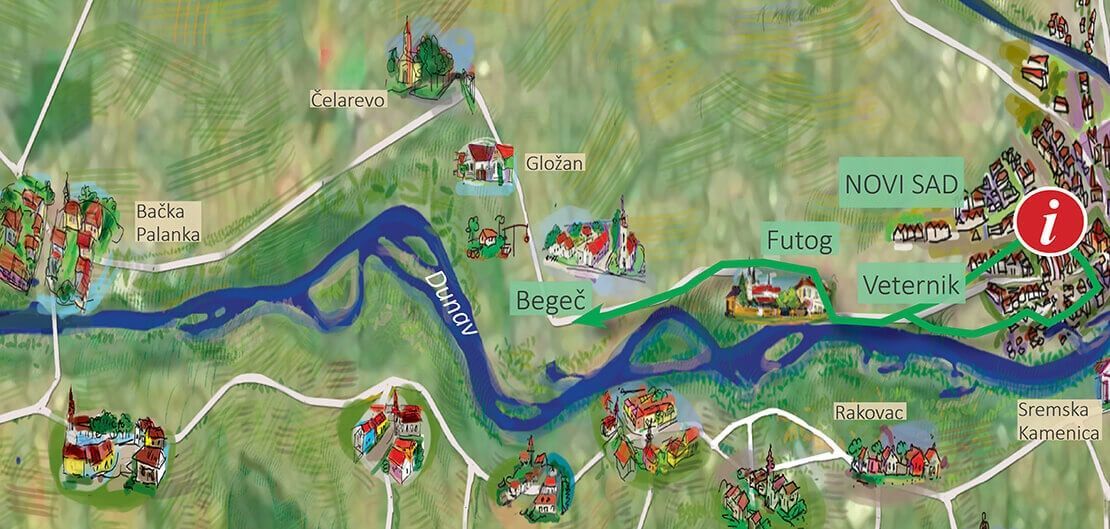
Ribarsko ostrvo i Kamenjar
Favourite places for relaxation, leisure, and good time are Ribarsko ostrvo, and Kamenjar. Ribarsko ostrvo is a Novi Sad weekend resort with the following restaurants and fish taverns: “Dunavska terasa” (Ribarsko ostrvo bb); “Kućerak kod česme”(Ribarsko ostrvo bb); “Dunavac km” (Ribarsko ostrvo bb); “Noina arka” (Ribarsko ostrvo 10). There is also the same named Tourist Resort “Ribarsko ostrvo”**** www.ribarskoostrvo.rs to which the following restaurants belong: “Ribarac”, “Alaska barka”, and “Alaska terasa”.
Kamenjar is a weekend resort with famous fish restaurants: Restaurant “Ribarska noć” (Podunavska Street 2); “Čarda Mačak” (Kamenjar bb), and “Fish meat & wine” (Kamenjar 83); VILLA PALACE 4* Kosmajska 23, Kamenjar 3.
Futog
Futog is an old settlement that has recently become a part of Novi Sad. The Roman Catholic Church of the Jesus’ Heart with the parish can be seen in its centre. The original church was built by Count Hadik in 1776. At the site of the old church, the Countess Chotek built a new one dedicated to Jesus’ Heart. The project was developed by Ferenc Veninger. Serbian Orthodox Church of St. Cosmas and Damian was built in Futog in 1776. The iconostasis was painted by Arsenije Teodorović, and wall painting is attributed to Janko Halkozović. The church keeps the collection of icons painted by Pavle Simić. Famous restaurants in Futog include “Plavi Dunav” (Ribarska Street 2X) and raftčarda “Dunavac” (Dunavska Street 000). www.splavdunavac.com
Begeč
Begečka jama is a nature park and popular picnic resort created on the old Danube riverbed. It spreads across the surface of 379 hectares. The place is known after its fishing sites, beach, weekend resort, fishermen’s centre and catering facilities. Begečka jama is one of the places along the banks of the river Danube from Bačka Palanka to Beška that is of great significance for the nesting birds.
Cvejin salaš *** Begeč, Nikole Tesle Street 2; Make sure to book in advance www.cvejinsalas.com
Cvejin salaš is authentic rural household where tourists are offered not only the specialities of domestic cuisine but also the accommodation in authentic household atmosphere of rural homes categorised with 3*. There are famous čarda in the vicinity: “Kod Braše” (Begečka jama 56), and “Čarda na jami” (Begečka jama bb).
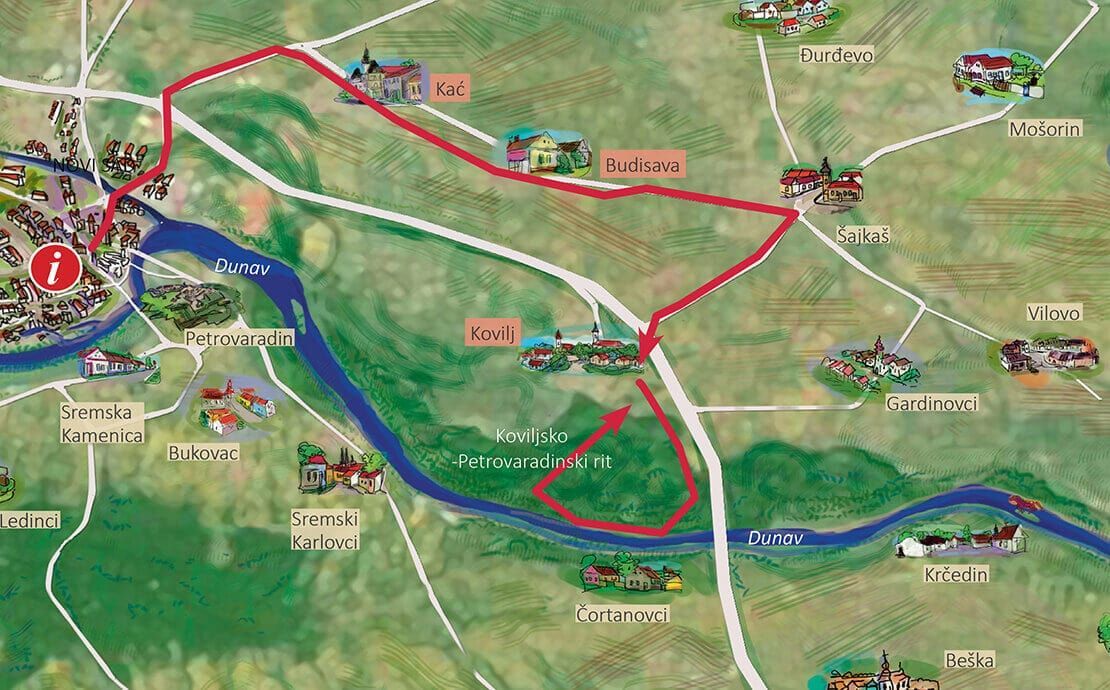
Kać is at the distance of 8 km from Novi Sad. Serbian Orthodox Church of St. Nicholas is in the centre of the settlement. It was built in the period from 1840 to 1844. This is where you can also see the Monastery of the Serbian Orthodox Church dedicated to Christ’s Resurrection.
The Black Whirlpool resort was designed specifically for those who love fishing. Budisava is one of Novi Sad’s suburban settlements. The Roman Catholic Church of Holly Mother is in its centre, and near it there is the Ethno House in Cara Dušana Street 107; Make sure to book in advance: E-mail: budiszava.petefi@gmail.com +381 (0)21 719 235 (9-14h); Rajšli Laslo.
Kovilj-Petrovaradin Marsh is a special nature reservation that spreads across 4,840 hectares of space in the territories of municipalities of Novi Sad, Sremski Karlovci, Indjija and Titel. A spacious reservation was created on the old arms of the river Danube. It is the habitat of rare bird species, and it is registered as IBA Area. Arkanj site is a well-known fishing resort.
Kovilj is the old settlement in Bačka that is located in the outskirts of Kovilj-Petrovaradin Marsh. The records mention it for the first time in the 13th century. The settlement has two churches and a monastery.
According to the legend, the Serbian Orthodox Monastery Kovilj with the church dedicated to St. Archangels Michael and Gabriel was founded by St. Sava. Its name was mentioned in the records for the first time in the 17th century. The monastery has had its current outlook since the middle of the 18th century. The iconostasis was painted by Aksentije Marodić, while wood carved pieces were made by Jovan Kistner. Serbian Orthodox Church of Christ’s Ascension (Upper Kovilj Church) was built in 1829. Serbian Orthodox Church of St. Thomas the Apostle (Lower Kovilj Church) was built in 1845 at the site of the previous temple. The birthplace of Laza Kostić (1841-1910), a writer, poet, and translator, is located beside the Upper Kovilj Church.
Tourists can visit:
Agricultural holding of Sava Graorac (with previous announcement) Phone: +381 21 29 88 558.
Sremska Kamenica is a part of the City of Novi Sad that is located in the foothills of Fruška Gora. It is known after a special microclimate enjoyable for stay. Its centre is dominated by churches and monument of Jovan Jovanović Zmaj.
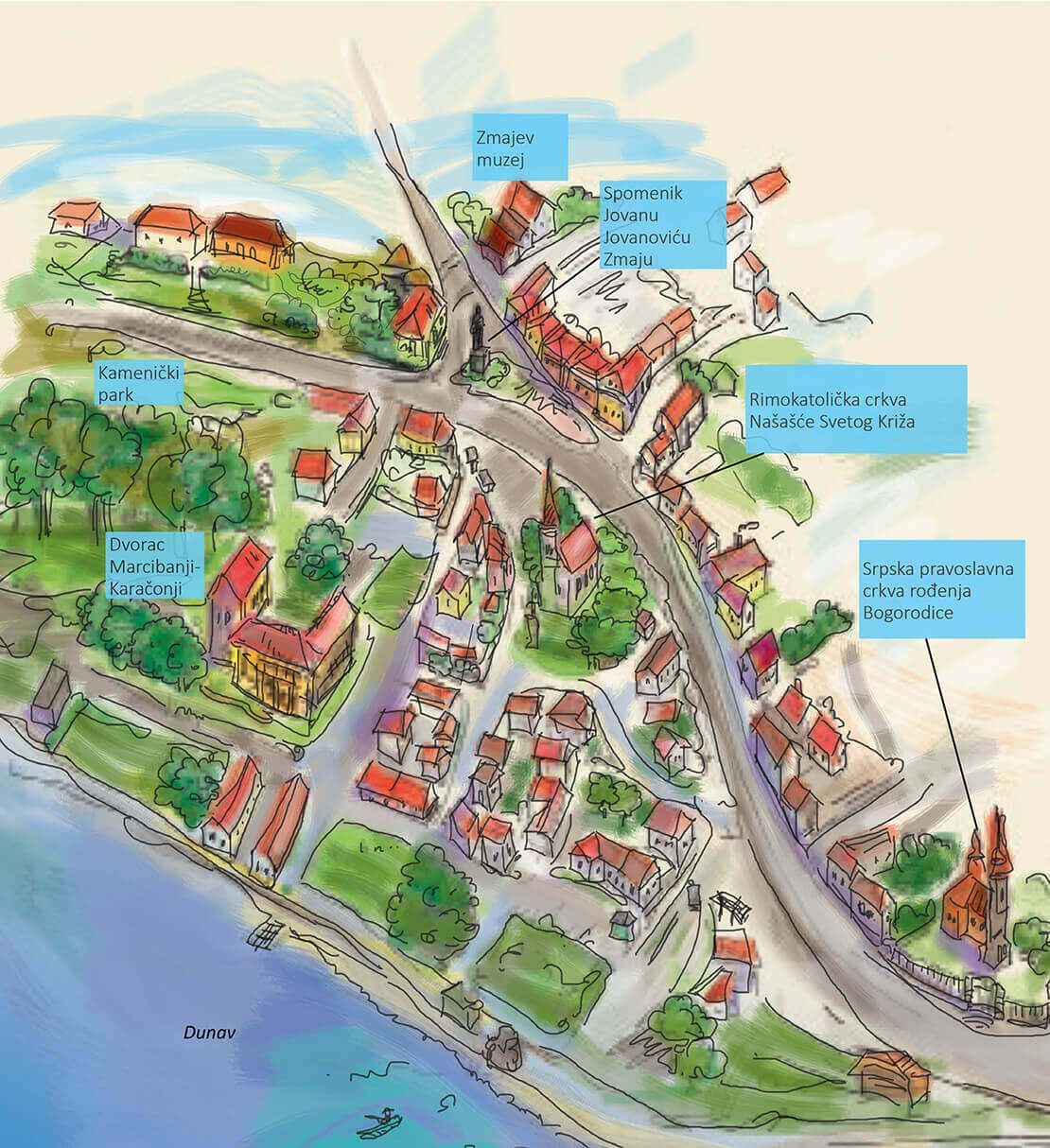
Serbian Orthodox Church of Holly Mother’s Birth is a baroque building that was built in 1758 at the site of a previous temple. Iconostasis was painted by Stefan Gavrilović in 1802. Roman Catholic Church of Discovery of the Holly Cross at Zmaj’s Square was built in 1811. The following monuments and cultural institutions are accommodated in Sremska Kamenica:
Marczibányi-Karátsonyi Castle is located, in Kamenički Park. Its current outlook dates back to 1836. Kamenički Park is a spacious, well arranged park that was initially created around the castle. It is decorated with sculptures from the former castle park.
Monument of Jovan Jovanović Zmaj (1833-1904), a poet, medical doctor, and member of the Serbian Royal Academy reminds of the fact that he has been our most read, and most famous children’s poet for many generations. In his honour, Novi Sad has been hosting Zmaj’s Games for Children since 1958. The house in which the famous poet and medical doctor, Jovan Jovanović Zmaj lived in the period from 1875 to 1904 is currently the Zmaj’s Museum. It is located in Jovana Jovanovića Zmaja Street no. 1 www.museumns.rs
Accommodation is available at:
Lodging “Vila Evanđelina”, Branislava Bukurova 2; www.vilaevandjelina.com
Lodging “Zmajevo Gnezdo” / Dragon’s Nest/, Zmajev trg 15; www.zmajevognezdo.rs
“Ilidža”, Ledinački put 1, Phone: 461-158 office@ilidza.rs.
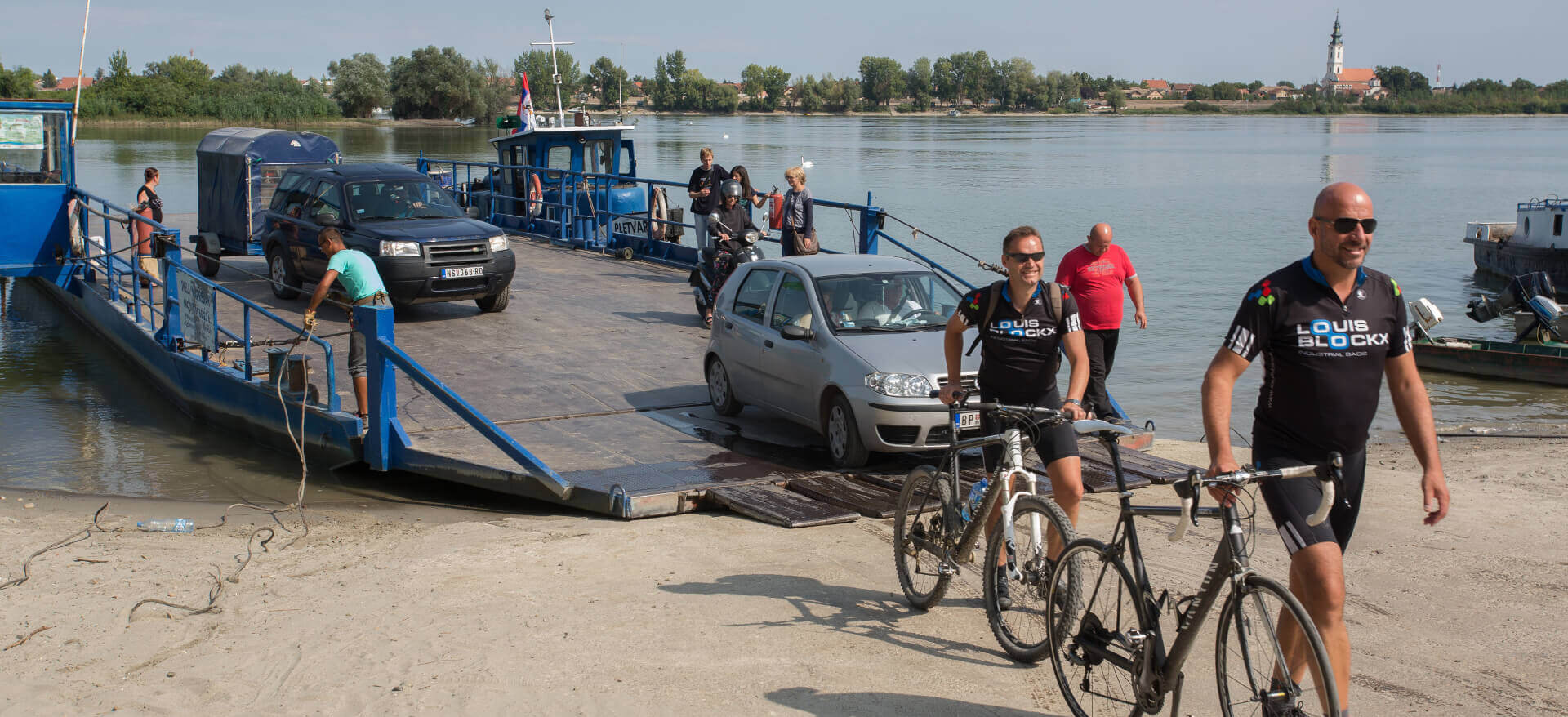
One-day excursions
BY FERRY ALONG THE LEFT AND RIGHT BANK OF THE DANUBE
Novi Sad-Futog- Beočin- Čerević-Banoštor-Begeč-Novi Sad
The tourist area of Novi Sad is exceptionally rich: wherever you go the layers of natural and man-made values and attractions appear in never ending sequence. Even the almost forgotten ways of transportation across the river, such as the ferries along the Danube near Novi Sad, can be included among tourist attractions. Crossing the Danube by ferry is a pleasant experience that is not expensive at all. However, the Danube is not a simple river, so it is recommended to use ferries in the summer or early autumn, when the grape is picked on the Srem side and last year’s wine is drunk, while Futog cabbage and Begeč carrots are sold on the Bačka side.
Futog
You can start your excursion by taking a ferry in Futog. It is believed that since 1250, when it is first mentioned in written sources, Futog has been constantly populated. During the Austrian rule, the settlement was such a significant marketplace that the fairs that were taking place were more famous even than those in Leipzig. The merchandise brought by the Turks, Persians, and Armenians moved towards central and northern Europe exactly across Futog district. The stories say that camel caravans used to cross into Bačka just at Futog on their road to Vienna, and that the coffee cargoes seized after the siege of Vienna at the end of the 17th century, embarked on their journey to conquering of European habits travelling along that same Futog road. Futog played an important role in defending the Habsburg Monarchy from the Turks because the Austrian army, under the command of Eugene de Savoy, crossed the Danube at that spot and went behind the Turkish lines, defeating them in the famous Petrovaradin battle in 1716.
While waiting for the ferry to take the same road that the caravans, traders, armies and travellers used to travel along before, do not miss the opportunity to visit the sights of Futog. In the vicinity of the Danube, in the part of Old Futog there is the Serbian Orthodox Church of Saint Cosmas and Damian. It was built in 1776 in the style of Baroque. Iconostasis was made in 1779 by Arsenije Teodorović, one of the most important Serbian painters of the 18th and 19th century. The wall paintings are the work of Janko Halkozović, a representative of early Baroque painting in Vojvodina. The church has a collection of icons painted by the Novi Sad painter Pavle Simić, whose painting expression is linked with the Nazarene painting. In the beautifully decorated and maintained churchyard, there is the grave of Smiljka Jovanović, the daughter of a poet Jovan Jovanović Zmaj who died very young.
At the beginning of New Futog, there is a remarkable Roman Catholic Church of the Jesus Heart, built at the site where a Baroque Church of the Holy Trinity used to stand in 1776. The contemporary church was built by the Count family Chotek in the period from 1906 to 1908. Gothic towers of this church are visible from a distance. The church is richly decorated; it has a pseudo-gothic style mobiliar and powerful organ, which, along with the monumentality of the building, gives the church a unique and harmonious impression of grandiose pageantry of the past times. The parish castle that was built in 1776 adjacent to the original church still exists. The relic of St. Eugene, a martyr from the ancient Christian times, whose body rested in the Roman catacombs, is still kept in the contemporary Church of the Jesus Heart. In 1777, the Pope Pius VI gave the relic to the Futog Church of the Holy Trinity built by the Count Andreas Hadik, and now it is kept in a glass sarcophagus beneath the side altar of the contemporary church. The text on the memorial plaque inside the church says that certain stained glass decorations were donated by Count Rudolph, his wife Maria Raday, daughter Henriette, sister Gabriela Schönborn, pastor Josef Eigl and some prominent families from Futog.
Hadik Castle, which was built in 1777 by the Count Andreas Hadik, Austrian field Marshall and chairman of the Vienna Royal War Council, is located just opposite the Roman Catholic Church of the Jesus Heart. The castle was built as a residential building in the Baroque style. Until 1805, it was the property of the Hadik counts and after that, it became the property of the Chotek family. Its new owners rebuilt it, built green house gardens and a big terrace at the front side. There are data evidencing that the castle hosted Duke Franz Ferdinand and his wife Sophie Chotek just before the assassination in Sarajevo and that Johann Strauss II composed the Beautiful Blue Danube while staying in it. It currently accommodates the Secondary School of Agriculture.
Just as each place along the river Danube has its “čarda” restaurants, “Splav Dunavac” is well known after its good fish soup and good wines.
Čerević
Futog ferry is not difficult to find and embarking is simple since there is a person responsible for accommodating passengers and vehicles according to a certain schedule. The ferry reaches Beočin in around ten minutes of a slow and cosy drive. From there, following the Danube bank, the ferry reaches Čerević. It is an old settlement and judging by archaeological remains it is assumed that there was a Roman fort in Čerević area. It is known that there was a Catholic parish there in the 12th century, while during the Turkish rule the census that was made proved the existence of mosques and Orthodox Church. The settlement was developing all until the arrival of the Austrians when it lots the significance it used to have as an important resting resort on the Belgrade-Budim road.
The centre of Čerević is dominated by the Roman Catholic Church of Saint Joseph today, which was built in 18th century. The Church holds the icon of Johann Natinhofer from 1781 with the Holy Family, while the landscape of Čerević with both the Orthodox and Catholic churches is presented at the painting bottom. The icons for this church were also painted by two famous Serbian painters – Arsa Teodorović (1817) and Konstantin Pantelić (1835). The references talk about the data that one Roman tombstone was built in the Catholic church wall.
The Orthodox Church of Saint Sava is in the vicinity. It was built in the 18th century in the Baroque style. The icons were made during the 18th and 19th century by unknown painters. The woodwork of the iconostasis was probably the work of Marko Vujatović during the first half of the 19th century. The churchyard is nicely arranged and it holds several preserved tombstones, including those of the benefactors Atanasije Gereski and Petar Kostić.
Čerević has its homeland museum that keeps the legacy collections of Milenko Šerban and sculptor Jovan Soldatović. In one of the central streets there is a plague informing us about the site of the birth house of a poet Milenko Grčić who was buried in the churchyard of the monastery Beočin.
There are a lot of wine shops and wine cellars in the settlement where you can taste and buy excellent wines: Neoplanta, Chardonnay, Riesling, Frankovka, Probus, Bermet, etc. All wine cellars and wine shops are well marked – they are the wine shops Kuzmanović, Belo Brdo, Radojčić, and Žabić.
Banoštor
Banoštor is an old settlement. In ancient times, there was a Roman fort Malata and Bononia there. The fortress had a harbour where, as it can be found in bibliography, two Roman emperors landed on their road to Sirmium: Julian in 361 and Grecian in 378. As Vera Milosavljević writes, the knowledge on the existence of the early Christian church from the 4th century near the present-day St. George’s Church is also of a newer date. There are also data about the medieval monastery in Banoštor, which was built, according to Vera Milosavljević, by the Serbian and Hungarian nobleman Ban Belos. Later on, the monastery was the centre of the newly established Srem Bishopric, which soon moved to Sremska Mitrovica. The name Banoštor is connected with the term “Ban Monoštor”, which in translation means “Ban’s Monastery”. In one seal from the 18th century, which is kept in the Archives of the Metropolitanate in Sremski Karlovci, the name of the place written in the old Cyrillic was “Banoštar Varoš”. In the Middle Ages and at the time of the Turkish rule, the fortress lost the significance it had in the Roman Empire time.
The rule of the Ottomans (1521-1718) erased many traces of the previous centuries, so that we can learn about earlier fortifications, the old Catholic parishes and monasteries, Orthodox Episcopes only from the written sources. One of such important documents is the list of Srem settlements, churches and monasteries made by the representative of the Prince Livio Odeschalci, the monk Giovanni Bonini in 1698 for the handover of that part of Srem, freed from the Turks and donated to the Italian noble family Odeschalci by the Austrian emperor Leopold I.
Today, the settlement is dominated by the walls of the Roman Catholic Church of St. Rudolph, built in 1913 by the Count Rudolph Chotek from Futog. The visitors may pay a visit to the Serbian Orthodox Church of St. George, built in 1682 in the time of the Great Migration of the Serbs under Arsenije Čarnojević. A great value is the iconostasis the woodcarving of which is the work of Maksim Lazarević from 1833. The icons on the iconostasis and a part of the wall paintings were made by Konstantin Pantelić in 1836, and the icon of the Holy Mother with Christ on the Holy Mother’s throne was made by Grigorije Davidović Opšić in 1781. The church bells are the gift of Mihajlo Pupin from 1925.
Banoštor is a village of winemakers and winegrowers. Here you will find excellent wines, and all wineries are well marked: Fruškogorski Vinogradi, Ačanski, Silbaški, Stojković, Urošević, Radošević, Šijački … There is also the Association of women involved in souvenir production called “Majkina Radionica” (“Granny’s Workshop”).
Begeč
The ferry that transports people and vehicles between Banoštar and Begeč is smaller than the one between Futog and Beočin, but equally safe. Crossing the river is even more interesting because the travellers are followed by a flock of cormorants and other birds in search of fish in the Danube shallow streams. The ferry stops at the bank in Begeč just next to “Čarda kod Braše”, which is a great place for a family lunch in summer. Begečka jama, a picnic area, a fishing terrain, bathing resort and a weekend settlement of the citizens of Novi Sad is only one kilometre away. Begečka jama is also a protected area – a nature park, significant for the survival of the nesting birds. Naturally, and to the joy of fish soup and other fish dishes lovers, there is another “čarda” restaurant that is “on duty” there in summer – “Čarda na Jami”.
At the end of the third century, there was a Roman fort and a docking facility (Castellum Onagrinum) in the Begeč area, but these archaeological remains are currently not available for visits. In addition, we can only learn from the reference sources about the history of the settlement during the Middle Ages and the Turkish times, because there are no material remnants from those periods. What can be seen today in the centre of the village is the Serbian Orthodox Church of Saint Luke the Apostle that was built in 1838. Somewhat further, on the main road to Novi Sad there is a “Cvejin Salaš”, an autochthonous rural household that is happy to receive visitors (with prior announcement). At this “salaš” farmstead you can be served with excellent homemade food, and you can also use the accommodation since this household is categorized with 3 *. Here, in a thick shade, with many domestic animals, with Vojvodina delicacies, you will find the easiest way to prepare for the return to the reality we live in.
Gordana Stojaković, September 2017
Information for tourists:
Group visits to churches
If you wish to visit the Roman Catholic Church of the Jesus Heart in Futog, it is necessary to announce the group visits to the parish priest Antun Kopilović at http://www.suboticka-biskupija.info/zupe.php
If you wish to visit the Roman Catholic Church of Saint Joseph in Čerević, it is necessary to announce the group visits to the parish priest Zdravko Čabrajac at http://www.srijembiskupija.rs/hr/abecedni-popis-zupa-u-srijemskoj-biskupiji.
Catering facilities
SUR Gostiona “Splav-Dunavac”, Dunavska 000; Futog +381 (0)21 895-406, (0)63 8882123, (0)600895406; www.splavdunavac.com. Opening hours: from 10.00 a.m. to 11.00 p.m. on workdays and from 10.00 a.m. to midnight on weekends.
SUR Čarda kod Braše, Begečka jama 56; Begeč +381 (0)21 899-111, 898-474; mail: cardakodbrase@eunet.rs. Opening hours: from 07.00 a.m. to 11.00 p.m. on workdays and from 07.00 a.m. to midnight on weekends.
Cvejin salaš 3* Nikole Tesle 2, Begeč, Tel: +381(0)21 2998 045, +381 (0)63 538 976 www.cvejinsalas.cominfo@cvejinsalas.com (announcement is mandatory)
Wine shops and wine growers from Čerević: http://www.fruskogorska-riznica.co.rs/?nav=pregled1&data=beocin&sub=1
Wine shops and wine growers from Banoštor https://banostorinfo.wordpress.com/2013/08/04/27/
Tourist Info Centre Banoštor: +381 (0)21 879 011
Ferries
We suggest you to plan your trip during the summer period. The Futog-Beočin ferry has regular route that starts every hour while the Banoštor-Begeč ferry starts when necessary.
Tourist Organisation of the City of Novi Sad is not responsible for changes in information and services.
References:
Slobodan Ćurčić Gordana Stojaković i Olivera Dobrivojević (2002) Fruška gora-Turistički vodič. Novi Sad/Beograd: Prometej i Vojnoizdavački zavod.
Vera Milosavljević (2014) Crkva u Banoštru. Sremski Karlovci: Srpska pravoslavna eparhija sremska
Dvorci Vojvodine http://www.dvorci.info/dvorci/futog/info.php
Spomenici kulture u Srbiji – Castellum Onagrinum, Begeč (sajt SANU) http://spomenicikulture.mi.sanu.ac.rs/spomenik.php?id=1316
Spomenici kulture u Srbiji – Rimokatolička Crkva Sv. Josipa, Čerević (sajt SANU) http://spomenicikulture.mi.sanu.ac.rs/spomenik.php?id=1046
Spomenici kulture u Srbiji – Rimokatolička Crkva Srca Isusovog, Futog (sajt SANU) http://spomenicikulture.mi.sanu.ac.rs/spomenik.php?id=1147
Spomenici kulture u Srbiji – Srpska pravoslavna Crkva Sv. Save, Čerević (sajt SANU) http://spomenicikulture.mi.sanu.ac.rs/spomenik.php?id=1045
Sveti Eugen –Nepoznati svetac http://www.zvonik.rs/arhiva/162/subisk.html
Subotička Biskupijahttp://www.suboticka-biskupija.info/zupe.php?op=display&zid=37
